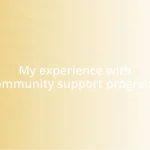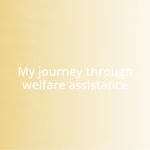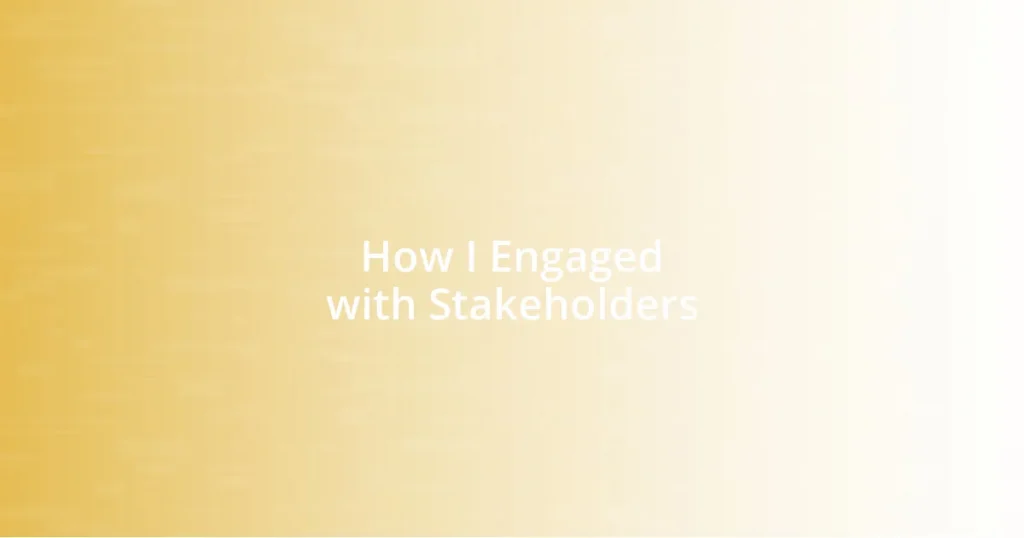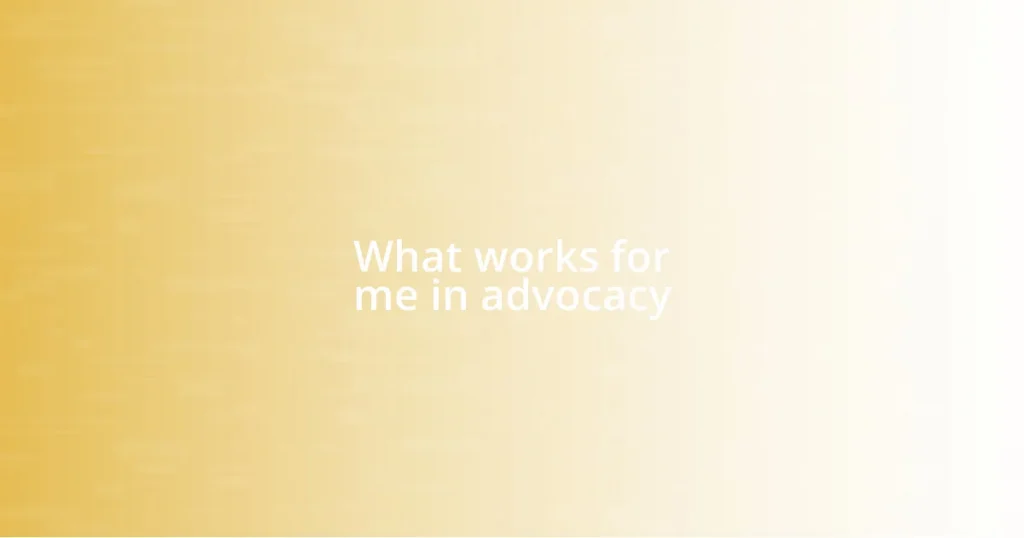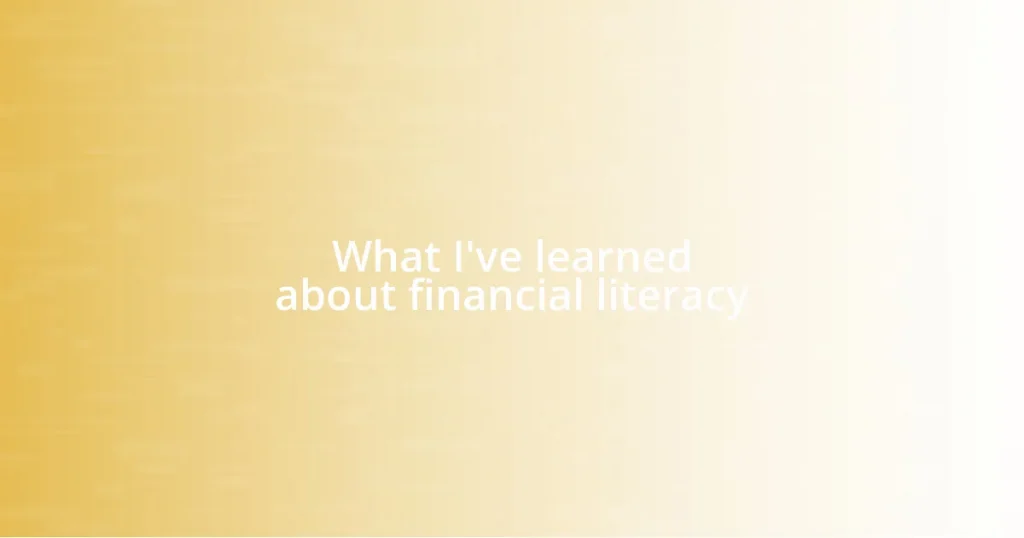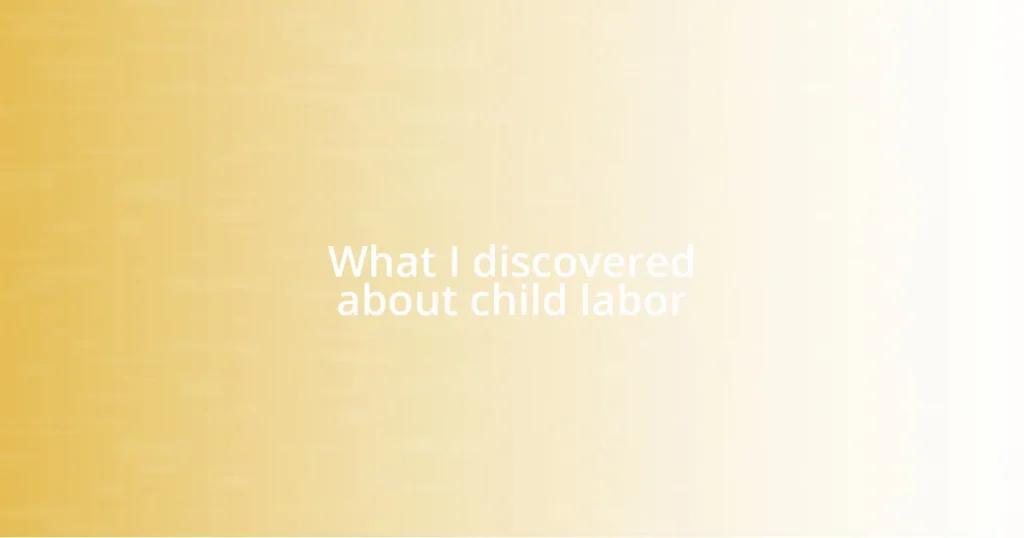Key takeaways:
- Stakeholder engagement is centered on building trust through empathy, active listening, and personal connections.
- Identifying key stakeholders requires mapping their influence and interest to ensure diverse perspectives are included in the project.
- Effective communication tools, including video conferencing and surveys, enhance stakeholder involvement and foster a sense of ownership.
- Implementing stakeholder suggestions promptly can energize teams and strengthen collaboration, showcasing the value of their contributions.
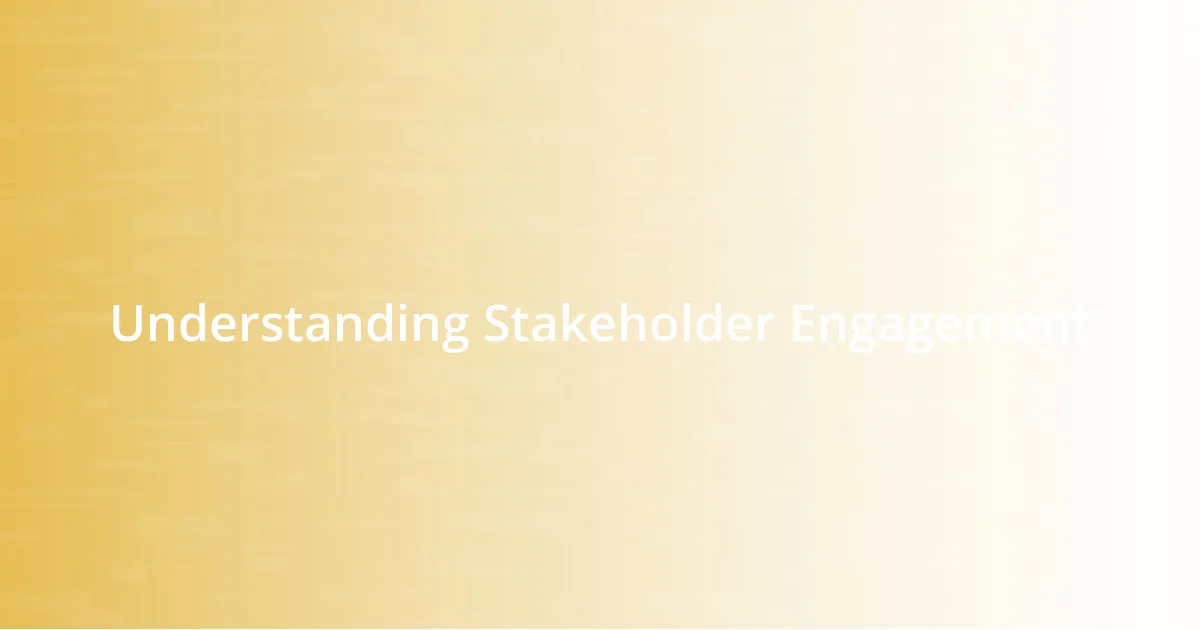
Understanding Stakeholder Engagement
Understanding stakeholder engagement goes beyond just involving individuals in a project; it’s about building relationships based on trust and mutual benefit. I remember a project where the stakeholders were initially skeptical of our approach. By taking the time to listen to their concerns and incorporating their feedback, not only did we enhance our strategy, but I also fostered genuine connections that lasted beyond the project’s end.
Engagement is often viewed through the lens of logistics — meetings, emails, follow-ups — but it can be incredibly personal too. In one instance, a stakeholder shared their personal experience with a similar initiative that had failed; it was a profound moment for me. It made me realize that each stakeholder has their own story, and recognizing that transforms a simple exchange into a partnership. Isn’t it fascinating how hearing someone’s journey can shift the entire narrative of collaboration?
When I reflect on my experiences, I see that true engagement comes from empathy and understanding. Asking questions like, “What do you hope to achieve?” not only clarifies objectives but also deepens connections. For me, these discussions often sparked unexpected insights that significantly shaped our project outcomes. Are you ready to explore how these connections can elevate your approach to stakeholder engagement?

Identifying Key Stakeholders
Identifying key stakeholders is crucial to the success of any project. In my experience, I’ve often begun this process by mapping out individuals who directly impact or are impacted by the project. For instance, during a community development initiative, I created a list that included not only local leaders but also residents who would be affected by our plans. This eye-opening discovery made me realize the importance of including voices that are often overlooked.
Once I’ve identified potential stakeholders, I prioritize them based on their influence and interest levels. I remember a project where a seemingly minor local business owner turned out to be a significant influencer within the community. Engaging with him not only led to advocating for our cause on social media, but it also helped bridge connections with other key players. This experience taught me that the true value of engagement lies in recognizing that every stakeholder has a unique role and perspective, often revealing opportunities we might miss otherwise.
Building a stakeholder map can be a game-changer when identifying key figures. It’s essentially a visual representation of connections between various stakeholders, helping us see overlaps and gaps in our engagement strategy. I once used this method for a corporate restructuring project, and it allowed me to pinpoint who needed more focus. This approach not only streamlined our outreach efforts but also created a more holistic view of the stakeholders’ ecosystem, leading to stronger partnerships and collaborations.
| Stakeholder Type | Importance Level |
|---|---|
| Primary Stakeholders | High |
| Secondary Stakeholders | Medium |
| Peripheral Stakeholders | Low |

Establishing Effective Communication Tools
Effective communication tools play a pivotal role in engaging stakeholders meaningfully. From my perspective, choosing the right channels can switch a mundane exchange into an empowering conversation. I remember using a project management platform during a particularly challenging initiative. It facilitated transparent updates and enabled direct feedback from stakeholders, which not only built their trust but also made them feel involved in the decision-making process. The line between facilitator and participant often blurs, creating a sense of shared ownership.
To strengthen communication further, I’ve found that diversifying methods is key. Here’s a quick rundown of tools that have worked for me:
- Video Conferencing: Platforms like Zoom allow for real-time discussions, fostering personal connections.
- Surveys: Anonymous feedback can encourage more honest input from stakeholders who might hesitate to voice concerns directly.
- Collaborative Documents: Tools such as Google Docs let stakeholders contribute ideas freely, promoting inclusivity and creativity.
- Regular Newsletters: Keeping everyone informed through periodic updates ensures no one feels out of the loop.
- In-Person Meetings: Sometimes, the old-fashioned way works best. Face-to-face interactions can strengthen bonds and clarify misunderstandings.
Selecting the right tool for the communication purpose is crucial. It creates an environment where all voices have the potential to resonate.

Building Trust with Stakeholders
Building trust with stakeholders starts with consistency. In one project I led, we set up regular check-ins and updates, ensuring transparency every step of the way. I found that consistently delivering on promises—whether big or small—reassured stakeholders and fostered a deeper sense of trust. Isn’t it incredible how a little consistency can turn doubts into confidence?
Another essential aspect I discovered is active listening. I remember a moment in a community engagement meeting when a stakeholder openly shared their concerns about our guidelines. Instead of defending our choices, I took a step back, acknowledged their perspective, and incorporated their feedback into our plans. This approach not only validated their voice but also created a sense of partnership. The power of simply listening cannot be overstated—don’t you think it helps us connect on a human level?
Finally, I’ve realized that building personal relationships is vital. During a stakeholder workshop, I took time to share a bit of my journey and experience, which opened up the floor for others to do the same. By sharing our stories, we created a mutual understanding that transcended professional boundaries. Trust, I believe, is often rooted in authenticity—what better way to nurture it than through sincere connections?

Gathering Stakeholder Feedback
Gathering stakeholder feedback can truly transform a project’s trajectory. I remember a time when I organized a feedback session using an online survey tool. What struck me was the sheer diversity of opinions that poured in—possibilities I hadn’t even considered were raised. It was a bit like a light bulb moment for me, reminding me how valuable it is to open the floor for honest dialogue. Have you ever experienced that rush of new ideas just from listening?
Sometimes, it’s not just about collecting data—it’s about creating an environment where stakeholders feel safe sharing their thoughts. During a workshop, I introduced small group discussions to give people a space to speak freely. Empowering voices that often go unheard led to truly rich conversations. I realized that when stakeholders see their viewpoints reflected in the action plan, it cultivates a sense of belonging. Just think about how energizing it is when you feel your input truly matters!
To ensure thorough feedback, I also encouraged follow-up interviews after broader discussions. During one particular initiative, I reached out individually to stakeholders who had expressed specific concerns. These conversations not only dug deeper into the issues but also contributed to a more robust understanding of each stakeholder’s unique perspective. Reflecting on those moments, it dawned on me just how crucial these one-on-one engagements are in fostering not just goodwill, but genuine collaboration. Don’t you agree that sometimes it’s the quieter voices that hold the most profound insights?
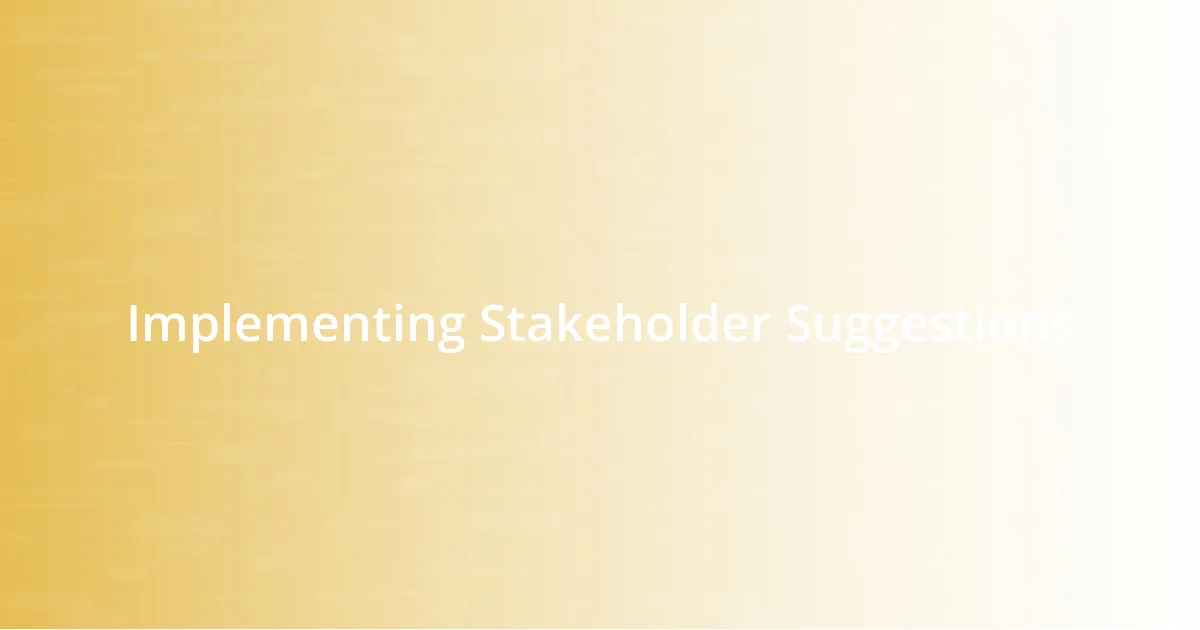
Implementing Stakeholder Suggestions
Implementing stakeholder suggestions is where the magic truly happens. I vividly recall a situation where a stakeholder proposed a new outreach strategy focusing on younger audiences. Initially, I was skeptical—would this really resonate? However, I decided to give it a shot, and the response was phenomenal. Not only did we broaden our engagement, but we also ignited passion among the team, revealing that sometimes taking risks on fresh ideas leads to remarkable outcomes. Have you ever been pleasantly surprised by stepping out of your comfort zone?
Additionally, I’ve learned that immediately implementing suggestions can foster enthusiasm. In a recent project, when a stakeholder suggested streamlining our reporting process, I acted quickly. Within a week, we piloted a new format. The enthusiasm during the next meeting was palpable—people appreciated that their input transformed into action. There’s something energizing about seeing your suggestions come to life, don’t you think?
Lastly, I find that sharing the results of implemented suggestions is crucial. After we tweaked our communication channels based on feedback, I made it a point to highlight the positive impacts in our next stakeholder update. I remember the pride on everyone’s faces; they felt part of the journey and its successes. Reflecting on those moments, it’s clear to me that celebrating collaboration not only fosters goodwill but also encourages ongoing participation. How often do we let our stakeholders know just how vital they are to our shared achievements?

Measuring Engagement Success
Measuring the success of stakeholder engagement can sometimes feel like juggling—several metrics need to be kept in the air. I remember when I first started tracking engagement through surveys and participation rates. It was fascinating to see how certain initiatives led to significant increases in attendance and active contribution. This quantitative data, combined with qualitative feedback, became my compass, guiding me to understand what truly resonated with stakeholders. Have you ever felt that thrill of uncovering trends in data that tell a deeper story?
I’ve also found that observing changes in stakeholder behavior is just as telling. For instance, after implementing a new feedback loop, I noticed a spike in proactive outreach from certain stakeholders who previously remained on the sidelines. This shift made me realize that engagement isn’t just about collecting opinions; it’s about fostering genuine interaction and trust. Isn’t it amazing how creating a culture of open dialogue can motivate stakeholders to take that first step toward involvement?
Finally, I believe that success should not just be measured by immediate results but by long-term relationships. One project I spearheaded initially faltered, but over time, I maintained consistent communication with stakeholders. This perseverance eventually led to richer, deeper connections. Reflecting on that journey, I understand now that measuring engagement success is an evolving process, where both immediate reactions and lasting relationships play a crucial role. How do you assess the health of your connections with stakeholders?






